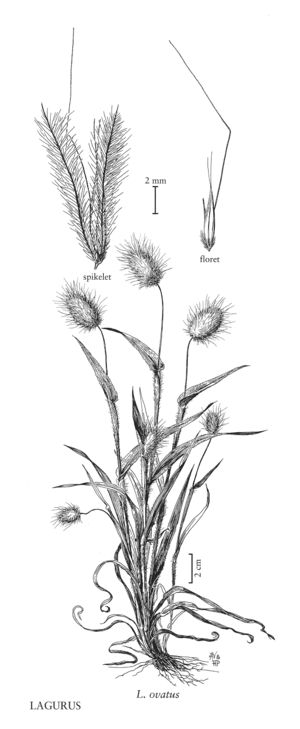| Taxon | Illustrator ⠉ | |
|---|---|---|
 | Lagurus ovatus | Linda Ann Vorobik Hana Pazdírková |
Plants annual; tufted. Culms 6-80 cm, erect or ascending, pilose or villous. Leaves pilose or villous; sheaths open nearly to the base; auricles absent; ligules truncate, erose, ciliate, abaxial surfaces densely pubescent; blades flat at maturity, convolute in the bud. Inflorescences terminal panicles, dense, ovoid. Spikelets laterally compressed, with 1 floret; rachillas prolonged beyond the base of the floret, pubescent; disarticulation above the glumes, beneath the floret. Glumes 2, equal, exceeding the florets, lanceolate, membranous, pilose, hairs 2-3 mm, 1-veined, veins acuminate and awned, awns pilose; calluses blunt, pubescent; lemmas lanceolate, pilose or scabridulous, 3-veined, 3-awned, apices bifid, lateral-veins extending as slender awns, not twisted below, central awn arising from the distal 1/3 of the lemma, twisted below; paleas nearly as long as the lemmas, veins scabridulous, extending as awnlike points; lodicules 2, narrowly elliptic, glabrous, apices minutely bilobed; anthers 3; ovaries glabrous; styles fused or separate. Caryopses stipitate, subterete, ellipsoid; hila 1/5-1/4 as long as the caryopses, ovate, x = 7.
Distribution
N.J., Alta., Ont., Que., Calif., N.C., Fla., Oreg., Conn.
Discussion
Lagurus is a monotypic genus endemic to the Mediterranean region. Lagurus ovatus has been introduced in North America, as well as South America, southern Africa, and Australia. It is sometimes cultivated as an ornamental, and the dried flowering culms are used in floral arrangements.
Selected References
Lower Taxa
"decumbent" is not a number.